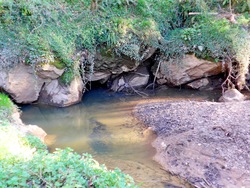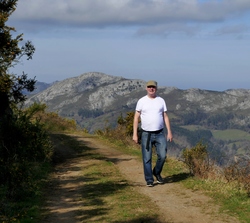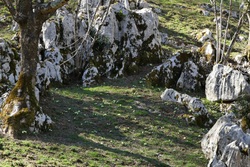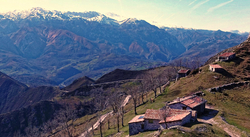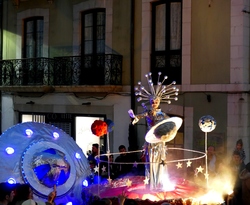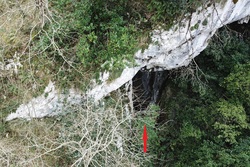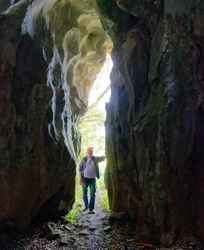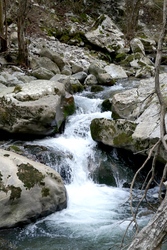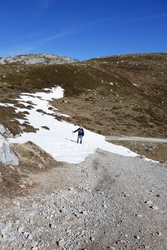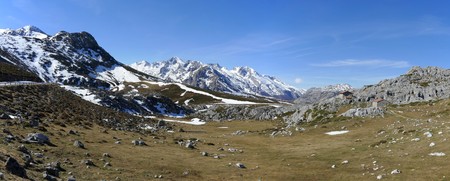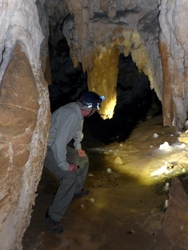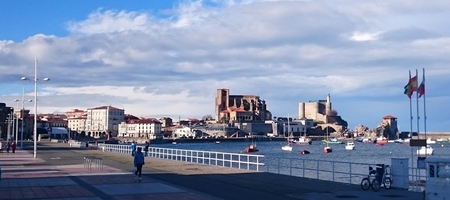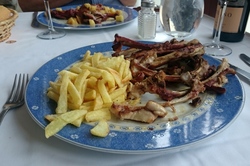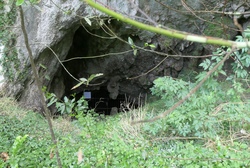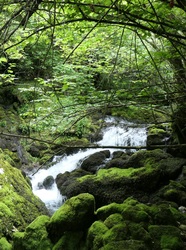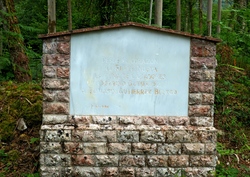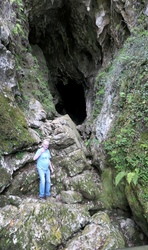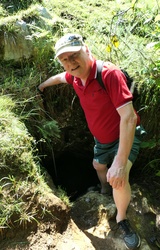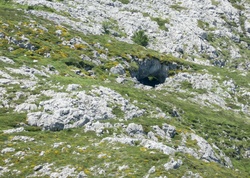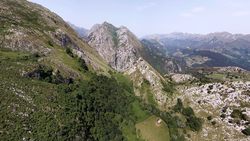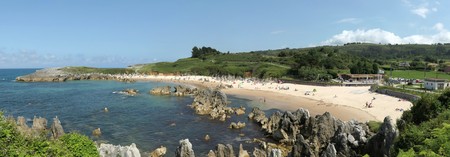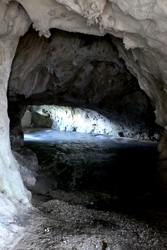

Introduction
Site list (GPS fixes) Walks (GPS tracks) Video clips Panoramas
Electronic projects:
Bat detector
Lamp tests
µ-controlled lamp
SEPIC-based lamp
ISP isolators
Making SMT boards
Expedition logs:
Spain 1973, 1974,
1975, 1976, 1977,
1979, 1982, 1983,
1985, 1986, 1987,
1988, 1989, 2000,
2001, 2002, 2003,
2004, 2005, 2006,
2007, 2008, 2009,
2010, 2011, 2012,
2013, 2014, 2015,
2016, 2017, 2018,
2019, 2020, 2021,
2022, 2023
Mexico
New England
Translation:
Expedition log, Spring and Summer 2019
Speleogroup made two expeditions to Spain in 2019.
- The Spring trip: Villa, Tebrandi, Boriza & Pozo de Fresno, Potes, Tresviso, Bolado.
- The Summer trip: Mazacuíos, Bufones de Santiuste, Boriza, Cobijeru, Rejo/Cofría, Tayada, Tenis.
Click on, or tap, any image thumbnail for a full-size version, or on a video clip to play at a larger size.
| Date | Activity |
|---|---|
| 28.02 | Mike arrived Bilbao on schedule, and with four hours to wait had plenty of time to review plans, maps, etc. Bill’s plane from Milan happily arrived 20 minutes early and Bill appeared landside just six minutes after touchdown! Picking up the hire car was also achieved in record time and we were soon on the road heading for our first speleological ‘site of interest’.
This was the Hoyo de Fuentejuyo sink (1.7 km SW of Oriñón) spotted on the map some months ago; in beautiful weather (17°C and blue skies) we descended close to the watercourse shown on the map but there was no detectable water and no real chance of getting to the assumed sink through dense undergrowth. So ... onward to the second objective. Again found from the map, the sink 📌 for the huge Hazas depression is 2.5 km WNW of the Oriñón resurgence (and quite likely to be its source). It was easy to get to and was situated beneath an impressive overhanging limestone cliff, which was festooned with various climbing aids. Somewhat as expected the water disappeared into various holes that were blocked by debris and mud, but definitely worth the check. A sign above it stated ‘Ojo de Recueva’. Day-one speleological objectives more-or-less achieved, we headed west via Oruña to Llanes. It being a February Thursday, most restaurants were closed but we had a pleasant light dinner at El Almacén. |
| 01.03 | Up at 9 and a brisk walk along the Llanes harbour quayside took us to the Bitácora bar for 2 large coffees. This still left us hungry so on our way to El Mazuco we also stopped at the Sidrería Jovino in Posada for yet more. We noted that they served food too!
After the difficulty finding open restaurants the previous night we checked “El Sucón” near Debodes but it was closed, and the restaurant “El Roxin” in El Mazuco was fully booked for lunch due to the (previously unknown to us) fiesta del Ángel de la Guarda. There was an unusual volume of traffic on the single-track roads. We decided to postpone the drone flying at El Mazuco (because it would probably have been impossible to drive back through the village) and instead drove up the track beyond the Ruiz Sanchez house in Villa (first frequented in 1973!). We parked at the westerly hairpin and proceeded to the TV antenna at the top of the ridge at 400m. Limestone all around, and to the south we could see the snow-covered Picos de Europa. To the north Vibaño and Rales. Total walking about 75 minutes (3 km). We decided on lunch at Casa María in Mestas de Con and had the menu del día at €12. Fabada for both, trout for Bill and escalope for Mike. Average quality food. Proceeding west then south we parked at the “Orandi Track” 📌 on the road to the lakes and ascended past banks of primroses until we got to the so-called meadow above where we expected the Trumbio cave passage to be. It certainly looked pretty with limestone pavement, occasional water courses, woods. The paths were mainly dry and only barbed wire presented obstacles. Mike found a small hole leading to a shallow pool but this is not very likely to be the entrance that our Spanish colleagues discovered. Total walking time 70 minutes again. Stopped in Benia for a drink on way back to Llanes. Dinner at La Llosa. |
| 02.03 | Up at 9:30; had coffee in Uria bar and had another in Sidrería Jovino.
Proceeded to Asiegu (about 2km NW of Carreña) and up the narrow unpaved
road north towards Tebrandi. Shock, horror! A vehicle coming down!
Then after passing, another driving up in the distance. As a matter
of courtesy to any landowners we parked at around 690m only to notice
that a rear tyre seemed very deflated! Would we be able to descend
without incident? Somewhat worried we walked the last 1.2km in bright
sunshine and a brisk breeze.
At the end of the road we checked the valley descending west but there was no sign of the two springs marked on the map nor any water course. In fact the bottom of the valley is not limestone at all. We retreated to the track again to launch the drone close to the high point of the track 📌 to take photos of the Sierra de Cuera (north) and the snowy Picos to the south; captured successfully in this spherical panorama [360°] (30MB, suitable for viewing with PanGazer ») which also shows the smoke from an unusual winter wildfire. After a very slow and careful descent we checked the tyres above Asiegu village and all seemed fine! The apparent deflation was due to the uneven and sloping ground where we had parked. Nevertheless we pumped up the tyre in Arenas where we had a lighter lunch of chorizo a la sidra and patatas con Cabrales (as we were in Cabrales, the cheese sauce was above average) at Sidrería Calluenga. Returned via Panes to Llanes via Vidiago to admire the “bufones”, where the rough sea forces air and sea spray through fissures in the limestone. There she blows! Back to Llanes to discover it was Carnival day. Mike found a viewpoint on the Town Hall steps and was surprised at the spectacle; it was much bigger than expected, with some very clever floats and troupes; it took an hour and a half for all to pass the Town Hall; the final troupe had 80 people or more. Dinner early at Taberna Mezcolanza (the old ‘El Gale¢n’) where we both had secreto ibérico (tender roast pork) washed down with Ribera del Duero. |
| 03.03 | To the ‘Mexican’ café for breakfast coffee; the café sported a number of people in carnival costumes and drinking beer; presumably the bar had stayed open all night.
Then to Posada for breakfast part two, and on up to El Mazuco in nice weather. Objective this time to investigate the Boriza possible high-level cave with the drone. As hoped, the lack of leaves on the trees gave much better views, and with tripod view settings (and more experienced pilot) we were able to fly the drone much closer than last year. Sadly, it still wasn’t clear whether there’s a going cave there – but there is a promising opening (see arrow in attached photo). Next back via the ‘car paddock’ 📌 to fly the drone over Pozo de Fresno, both Mike and Bill piloting, to again take advantage of no leaves on the trees – although the white Ash twigs acted quite effectively as a net curtain. Missions accomplished for the morning we headed in the direction of Ribadesella in search of lunch. We ended up at the (new to us) Sidrería Muros in Nueva de Llanes which seemed partly built of barrels and had a fine grill – so somehow secreto ibérico was eaten again! Just as good as the evening before in Llanes. Perfect weather again, so then North to the Playa de Cuevas del Mar for various explorations of many small caves at the beach and a little inland. Then, as the wind was picking up ahead of storm Freya, a longish walk to the Bufones near Llames; spectacular waves, more noisily-venting holes, and spouting sea-water geysers. |
| 04.03 | The weather forecast had predicted a cold and very wet day but blue skies and sunshine welcomed us yet again when we got up at the usual 9:30 for breakfast. Nevertheless we persisted with the ‘wet’ plan, driving south from Unquera and up the Deva Gorge. Due to lack of safe parking places we cancelled the drone flight up to Pozu del Infierno entrance, so our first stop was at La Hermida. La Cuadrona, where we had hoped to get a plate of Picón de Bejes (blue cheese), was closed, but the Bar Restaurante Paquin was open and we had a small glass of Rioja.
In 2018 we had been unable to reach the town of Potes (further south) due to road works. This year, the road was open but surprisingly the road works were still continuing, widening the narrow road and bridges up the gorge. The lights directing the alternating one-way traffic were not well synchronized and we had a worrying moment encountering an oncoming truck head-on at a blind corner. We stopped for a hike up the track towards Cicera, but the entire valley was in the shade so it was rather cold. Retracing our footsteps we returned to the car and reached Potes only to find it was market day and parking was difficult. Had a plate of Picón cheese washed down with Protos (Ribera del Duero) at the “La Serna” bar after walking round the town. Hunger not being satisfied, we had yet another plate of a different Picón (Tresviso) at Paquin, but the tinto was “corked” (very rare in Spain) and we did not finish it. Returning to Llanes we stopped on the coast to watch (and hear) the Bufones at Vidiago. The sea was rough and we were rewarded by high waves pushing air and salt sea spray through caves. There she blows! Most restaurants in Llanes were closed outside the weekend but Uria was open, where we were served by the same lady as 40 years ago! Paella for both then lomo for Bill and filete al Cabrales (with blue cheese sauce) for Mike. |
| 05.03 |
Weather all blue-sky again, so off to the mountains via Arenas de
Cabrales, Tielve, and Sotres, to the little TV mast at 1240m (Cdo.
de la Caballar) where we stopped for a lookaround – and found that
the very keen wind gave strength to our plan to go downhill when
we started walking. Our start point was the junction of the Bejes
track with the Sotres–Tresviso road, at 1300m. Spectacular scenery,
enlivened by the drifts of icy snow that caused us some (but not
too much) walking over the snow. The rapid loss of height and the
temperature when not out of the wind made this a shorter walk than
usual, but a good one. Carried on to Tresviso to re-acquaint with
the rustic bar and its fine views.
On the way back we noticed a cave entrance at 📌 (approximately), visible from the road ESE .. to be added to the summer to-do list [interestingly it is not visible on StreetView, due to trees]. Although we had the drone in the car, this is (just) inside the National Park, so no flying of any kind is permitted; this will have to be an exploration on foot, fortunately a track goes close by. Lunch of cabritu (goat kid) at the Sidrería Calluenga in Arenas – asado for Bill, chuletillas for Mike. Not as good as lamb, but very acceptable. Back to Llanes via Posada, but as it was relatively early and we were feeling keen, we diverted to Cueva Bolado for some real caving. Almost found the main route on the first try, and soon got to the main sandy cavern at the end; the stalagmites looked amazingly pristine and white. The big surprise was finding a stream in the cave that we’d never noticed in summer visits; on exiting we soon found its resurgence. Back to the hotel, and another dinner in Almacén (remarkably few restaurants being open). |
| 06.03 | Because of Bill’s early flight on the 7th, today was a travelling day
to move closer to Bilbao. As we paid the bill at Hotel Sablón we
were pleasantly surprised to receive a gift of local cheeses at reception!
We drove east via La Borbolla (with a walk towards the resurgence,
and noticing an orange tree ‘in fruit’). No sign of any abandoned
high level resurgence was seen notwithstanding the lack of obscuring
vegetation at this time of year.
Next stop was Restaurante Las Filipinas in Comillas for a drink before proceeding to Puentecilla for lunch. We had a relatively expensive menú del día at €17 each. The merluza (hake) stuffed with mushrooms was good and unusual.
After lunch there was some light rain and we arrived in Castro Urdiales at 15:30. Went to the ‘green bar’, checked into the hotel Las Rocas, then (as the rain had stopped) walked round the town. La Marinera bar and many others were closed. Later, it started raining more seriously as we were writing up the log, so dinner in the hotel cafetería (the restaurant was ‘closed’). |
| 07.03 | Up early to catch Bill’s 10:45 flight; uneventful travels except atrocious driving weather in the UK. Mike makes up for a week of few vegetables with a seriously veggie lunch. |
| Date | Activity |
|---|---|
| 19.06 | Bill up at 5:30 and on his way to Malpensa airport at 7:30 arriving
at 9:45. It took just 5 minutes to get off the plane on time at Bilbao.
The Europcar office recommended the Loiu Sidreri about 5km away for
a self-service lunch (€16) (as much food, wine, cider, and beer
as you like). Good value.
Then to Castro Urdiales and La Marinera bar. When Mike’s ETA was
postponed for the second time to 22:30 (from 21:00) Bill had 3 pinchos
and 2 Riberas as a substitute for dinner. Then back to the airport
again but on arrival learned that Mike’s flight was cancelled. Bill
decided to head for Montemar Hotel in Llanes as four local hotels
were full; arriving at 12:30 (200km from airport).
|
| 20.06 |
Back East again after breakfast to pick up Mike at 12:20 at Bilbao
airport (his replacement flight also being delayed). Hungry, we
both agreed to head for the Casanova restaurante in Arredondo. Bill
chose cabrito and Mike had chuletillas. Excellent!
We took an inland route towards Solares and detoured to El Coladillo (1km S of La Cavada) to look at a large depression taking a stream. But, lacking appropriate gear, we didn’t actually see if there was a real cave entrance – turning back just 25m from the presumed sink 📌 near a waterworks building. After stops in Torrelavega and Pendueles, we arrived in Llanes in the drizzle to book into Montemar. Then dinner in Canene (€18 for 2). |
| 21.06 | Dark skies and light rain, as forecast, didn’t stop us foraging for
coffee and a shoehorn before heading Southwest to Ortiguero. As
we drove the rain happily tailed off, and we carried on to Arenas
where a walk-around revealed no significant changes since March.
Next East down the Cares river valley, with a stop at Casa de la
Molinuca (600m S of Cueva Llonín). Then on to La Hermida for the
(now traditional) queso picón, followed by lunch (lomo for
both).
It now being sunny and warm, we headed to the coast – to La Franca (where we camped in 1982) to look for Cueva Mazacuíos, recently spotted on the map. After viewing some unusual buildings hidden above the main road, we spotted a very speleological cliff-face which indeed had the cave entrance at its bottom 📌; fenced off, unfortunately. On to the the next objective, 1km NW of the La Franca beach: Bufones de Santiuste – where there was a big sea cave 📌 with a vertical opening 60m inland. New to us, this had an impressive almost 20m near vertical drop to the water; in stormy weather it clearly could be spouting seawater up to the surface. Back to Llanes via Pendueles. |
| 22.06 |
After breakfast we drove to El Mazuco village to book lunch and then
descended into the Bolugo depression and parked at the end of the
road with a view to locate the resurgence to the Boriza system and
precisely locate its position using GPS. We had been inside the
cave in the 1980s, but land-use changes had transformed the closed
valley into a jungle of undergrowth and woodland making access difficult.
Further obstacles included the slippery ground, still muddy from
the previous rain. In fact Bill fell and hit his nose on a climb
close to the presumed resurgence. There appeared to be a number
of resurgences everywhere at the head of the valley. The easiest
way to proceed was up the main stream but we were forced to reconsider
that approach at a 2m cascade 📌
– probably just 15m from the cave proper.
Disappointed, we retreated by a different, even muddier, route to the car and from there to the Roxin bar-restaurant at 13:00. Chorizo criollo and patatas alioli plus a jug of red. Later, for dinner, Bill had secreto ibérico (tender pork) while Mike ordered merluza a la plancha (hake) at the taberna Mezcolanza. |
| 23.06 | Cloudy start – just a few drops of rain as we drove West to Nueva
and thereafter increasingly pleasant and sunny weather. The objective
this time was the Llamigo resurgence cave, in the Reguero la Friera,
which we surveyed in 1975, with a new approach
plan to get to it from below. Logging road soon found (just before
[North of] the first bridge over the Río Nueva, some years ago
the start of an epic drive up towards Cueva Negra) about 1km S of
the ‘bypass’ around Nueva. Drove on up to the sink for the cave
📌 before returning to the bottom
of the valley and starting the walk.
The tracks were kind; we followed the logging road to a junction with a monument, then another track followed the river (Río Nueva) just where we wanted to go. When we got to the point where we expected the stream from the Llamigo resurgence to join, there was no sign of the stream and the river looked uncrossable (dryfoot), however just around the corner a ford and log bridge took us to the other bank and another track that soon crossed the target stream and headed up the valley in the ideal direction. Unfortunately it was overgrown with gorse and brambles and after a while became impassable; a machete would have helped! Back to the main river and followed it upstream for a while; a pleasant walk but nothing speleological. El Sucón, near Debodes, for a good Sunday lunch of lomo and chuletillas before returning to Llanes with a stop at Puente Nuevo for dessert of excellent Gamonéu cheese. |
| 24.06 |
East to Buelna and walked to the Cobijeru inland beach and cave.
This is nice walk along a stream which sinks and resurges at intervals.
Some of the entrances appear penetrable, but are too muddy or tight
to encourage exploration. Our objective was the easy Cobijeru
cave a few metres east of the inland beach. It’s interesting because
one can get completely out of sight of daylight and the passage then
opens into a wide chamber and more entrances at sea level.
Next we drove to Camijanes and the “Senda Fluvial” (river footpath) along the Nansa river to seek Cueva Rejo (800m walk). This is a spectacular vadose cave which probably connects with Cueva Cofría in the depression above. The large entrance was draughting strongly suggesting that a through trip may be possible. In previous years we had seen bats in this cave and a Google search suggested the cave is the home to half a dozen species (listed here). Mike was keen to try out his electronic bat detector but with null results (somewhat expected as it was daytime). We didn’t see any bats either! As Restaurante Gloria was closed we went North to San Vicente and had a below average lunch of merluza with too much batter (Mike) and sulas (whitebait, for Bill). We didn’t appreciate the later dinner in Llanes either – slow surly service, over an hour for one dish each, and dirty glasses. But the food was adequate; gambas al ajillo for Mike and jamón Serrano for Bill. |
| 25.06 | The weather forecast suggested a dry morning and wet afternoon so we
headed West towards a limestone patch near Oviedo; by Ribadesella
the drizzle had turned into rain, so plans quickly morphed to a show
cave (Tito Bustillo – closed) then a nearer limestone patch close
to Vallobil, 6km S of Arriondas. The area was duly reconnoitred,
including an ‘orange’ road that turned out to be an unpaved track
– but limestone was even more elusive than good weather. There
was a bar in Vallobil – but it was closed on Tuesdays...
Headed East and North to Puente Neuvo for a pleasant plate of picón followed by lunch at El Sucón. The sun came out in the afternoon – quite contrary to the forecast – so a long walk around Llanes proved possible. |
| 26.06 |
Low cloud at first, but this lifted as we drove towards Ortiguero,
and at the pass (foggy earlier in the trip) it was all but gone,
and by the time we got up from Canales along the passing-place-free
track to Minas de Alda 📌
there were only a few wisps of cloud, leaving clear blue sky and
very welcome sun. We parked at 535m and hiked down the tracks to
Cueva Tayada, confirming our previous GPS exactly. The muddy slippery
entrance climb did not invite (and we had already explored the cave
well in 2009), so we returned up the 70 metres of
ascent (with the sun now a little less welcome) to the car to get
out the drone for a spherical panorama [360°] of the Jous de Alda depression and the cave.
To Arenas for the first fabada of the trip at a new restaurant for us (“Dos Hermanas”), and, thus fortified, up the mountain to Sotres to search for the cave spotted in March. Despite spotting it again from the road, it proved difficult to get to from above, despite much bracken- and gorse-bashing. Some very pretty ‘alpine’ flowers were noted, as was their prickly foliage. Next time we’ll try an approach from below; close inspection of photographs [later] revealed that the cave is in fact an arch, possibly also a cave entrance. Back to Sotres for a much-needed cold beer, then via Ortiguero to Cueva Cosagra (‘Cueva Geoffo’) where there was a probable bat-detection. Tabla de quesos for dinner, followed by an unsuccessful attempt to detect bats near the Llanes river. |
| 27.06 | Blue skies in the morning so good drone weather. Drove East to
Suarías (above Panes) for aerial reconnaissance of Cueva del Arco
next to a natural cave arch overviewing one of the large depressions.
This cave was discovered on the spring 1976 trip, and revisited in
1982 and 2010.
From the ground we could not see the arch nor even identify where it should be [logs for the earlier visits do mention that it can only be seen from a narrow range of positions]! But we sent the drone up anyway for videoing and took a panorama [360°]; see right for extract. Unfortunately undergrowth obscured part of the view so maybe another March trip will be planned. Returned via Casa Poli in Puertas de Vidiago for a snack of smoked Gamonéu cheese washed down with “Pruno” Ribera del Duero. Before dinner a short trip into Cueva Bolado (out of sight for daylight) to detect bats – none heard, but it was well before sunset. However, bats successfully detected in the streets near the hotel, and near Paseo San Pedro, after dinner. |
| 28.06 | Another sunny morning so off to the East of Comillas, in Cantabria.
First plan was to check out a possible resurgence at the Arroyo de
la Mina, but this was abandoned as the valley, near La Iglesia, was
dry. Then we took a track South hoping to examine the depression,
1+ km in diameter and 150m deep marked on the map as Vallosero.
The car managed it to the 5km track which circles the depression
but this new track was so uneven we proceeded on foot. The view
of the bottom of the depression was obscured by tall gorse and eucalyptus
trees. After walking a km we retraced our footsteps and then drove
to Comillas for a menú del día in the town centre (insipid
paella but excellent lubina a la plancha).
Returned to Llanes after visiting the Bufones de Arenillas at Puertas de Vidiago, and a cool drink in Cue; stopped above Playa Toró for a quick panorama: After dinner Mike went bat detecting, with success! |
| 29.06 | Somewhat cloudy and humid at the coast, but dry. We decided to head
South where less cloud expected. First stop was Coto del Infierno
in the La Hermida gorge to launch the drone to view Pozo del Infierno
entrance, first visited in 1973 (and happily just outside the no-fly
National Park boundary). Not entirely successful as being deep in
the the gorge the drone reported ‘weak GPS signal’ and refused to
fly higher than 30m – but a nice panorama [360°] was captured.
Next to Bejes for a plate of Picón de Bejes cheese, made at the Quesería Brañuca just yards away, while sitting in the bar with views of mountains all around. After adding a plate of jamón we decided the two plates would suffice for lunch if topped up with a mid-afternoon snack. Bought a cheese at the Quesería before heading back to Llanes via the Cares gorge, Arenas, Ortiguero (for the afternoon snack – another plate of cheese), Posada, etc. |
| 30.06 |
Cloudy start (fine later). Headed West to Ribadesella and a through
trip (and back) in Cueva Tenis in the Área Recreativa de Ardines.
Next to the nearby ‘pretty villages’ of Abeo and San Pedro which
had been on the to-do list for some time; nothing especially pretty
in either. Back to Ribadesella for lunch, of which the most interesting
dish was esparagos al cabrales – asparagus with a blue cheese
sauce rather than the usual mayonnaise.
After lunch a visit to the West bank of the Playa de Guadamía – impressive karst cliffs – followed by a walk among the Bufones de Pría, completing a hat-trick of bufones. Back to Llanes to pack, dine, etc. |
| 01.07 | Early start for 11:00 flight from Bilbao; brief stop for coffee in Bar Verivan, Castro Urdiales. Uneventful trips home. |
Notes:
- Exchange rate: 1.16 → 1.12 EUR/GBP (compared to 1.425 in 2015, 1.26 in 2016, 1.14 in 2017 and 2018); 85.5p → 90p = 1 Euro = 166 pesetas (194 → 184 pts/GBP).
- Petrol was €1.259 → €1.22/litre.
- Weather: essentially perfect in Spring; it could have been May or June, not March. A little rain on the final (mostly travel) day. More mixed in Summer; some rain/cloud in the first week; clear sun for final few days.
- The drone flown was a DJI Mavic Pro »;
33+32min in total.
GPX tracks of the drone flights may be available if you contact us. - The pictures in this log were taken using a Panasonic TZ100 or TZ200 camera, a Panasonic LF1, various phones, and the drone.
- 360° panoramas are very large and so are not displayed in this log; instead, click on the [360°] marker to open and then save the panorama, or right click to save directly.
- Specific GPS positions are shown by a pushpin symbol (📌) in the log above – click on the symbol for a Google Maps view of the fix. These positions are also listed on the Speleogroup site list page with coordinates in °,′,″ degrees using WGS84 datum and in UTM coordinates; see Coordinate systems.
- Fixes and tracks were recorded using a Sony Xperia Z3 Android ’phone using the MyTrails app (or by the drone, for drone flights).
- This log was almost entirely edited in the field on a Lenovo Yoga notebook, using the MemoWiki » extended Wiki notation which is then processed by a Rexx » script to generate the HTML for this web page.
